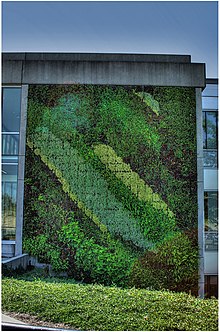
A green wall is a vertical built structure intentionally covered by vegetation.[1] Green walls include a vertically applied growth medium such as soil, substitute substrate, or hydroculture felt; as well as an integrated hydration and fertigation delivery system.[1][2] They are also referred to as living walls or vertical gardens, and widely associated with the delivery of many beneficial ecosystem services.[1][2]
Green walls differ from the more established vertical greening typology of 'green facades' as they have the growth medium supported on the vertical face of the host wall (as described below), while green facades have the growth medium only at the base (either in a container or as a ground bed). Green facades typically support climbing plants that climb up the vertical face of the host wall, while green walls can accommodate a variety of plant species.[2][3] Green walls may be implanted indoors or outdoors; as freestanding installations or attached to existing host walls; and applied in a variety of sizes.
Stanley Hart White, a Professor of Landscape Architecture at the University of Illinois from 1922 to 1959, patented a 'vegetation-Bearing Architectonic Structure and System' in 1938, though his invention did not progress beyond prototypes in his backyard in Urbana, Illinois.[4][5] The popularising of green walls is often credited to Patrick Blanc, a French botanist specialised in tropical forest undergrowth. He worked with architect Adrien Fainsilber and engineer Peter Rice to implement the first successful large indoor green wall or Mur Vegetal in 1986 at the Cité des Sciences et de l'Industrie in Paris, and has since been involved with the design and implementation of a number of notable installations (e.g. Musée du quai Branly, collaborating with architect Jean Nouvel[6][7]).
Green walls have seen a surge in popularity in recent times.[2] An online database provided by greenroof.com for example had reported 80% of the 61 large-scale outdoor green walls listed as constructed after 2009, with 93% after 2007.[8] Many notable green walls have been installed at institutional buildings and public places, with both outdoor and indoor installations gaining significant attention.[9] As of 2015, the largest green wall is said to cover 2,700 square meters (29,063 square feet) and is located at the Los Cabos International Convention Centre designed by Mexican architect Fernando Romero.[10]
- ^ a b c Medl, Alexandra; Stangl, Rosemarie; Florineth, Florin (2017-11-15). "Vertical greening systems – A review on recent technologies and research advancement". Building and Environment. 125: 227–239. Bibcode:2017BuEnv.125..227M. doi:10.1016/j.buildenv.2017.08.054. ISSN 0360-1323.
- ^ a b c d Cite error: The named reference
:0was invoked but never defined (see the help page). - ^ "Vertical gardens in the city: how to green up your apartment building creatively".
- ^ Hindle, Richard L. "Reconstructing the 'Vegetation-Bearing Architectonic Structure and System (1938)'". Graham Foundation. Archived from the original on January 25, 2013. Retrieved February 20, 2013.
- ^ Hindle, Richard L. (June 2012). "A vertical garden: origins of the Vegetation-Bearing Architectonic Structure and System (1938)". Studies in the History of Gardens & Designed Landscapes. 32 (2): 99–110. doi:10.1080/14601176.2011.653535. S2CID 56350350. Archived from the original on 2019-06-26. Retrieved 2019-06-26.
- ^ "Vertical gardens a green solution for urban setting". The Times of India. Feb 14, 2013. Archived from the original on May 6, 2013. Retrieved February 20, 2013.
- ^ "Welcome to Vertical Garden Patrick Blanc – Vertical Garden Patrick Blanc". www.verticalgardenpatrickblanc.com. Archived from the original on 2017-01-06. Retrieved 2017-01-06.
- ^ "The International Greenroof & Greenwall Projects Database!". greenroofs.com. Greenroofs.com, LLC. Archived from the original on 18 October 2013. Retrieved 17 October 2013.
select 'green wall' as type and 'living wall' under 'greenroof type'
- ^ "Upwards trend". www.airport-world.com. Airport World. Archived from the original on 31 July 2016. Retrieved 29 March 2013.
An increasing number of airports are investing in vertical gardens and living walls to create a unique setting
- ^ For largest wall as of 2012, see Eric Martin; Nacha Cattan (Jun 20, 2012). "Calderon Fetes G-20 as Sun Sets on Mexico Ruling Party". bloomberg.com. Bloomberg LP. Archived from the original on 16 April 2015. Retrieved 17 October 2013.
- For size of wall, see "Los Cabos International Convention Center (ICC)". greenroofs.com. Greenroofs.com, LLC. Archived from the original on 3 March 2016. Retrieved 17 October 2013.